One of the best ways we can set our young children up for kindergarten and beyond is by introducing them to the alphabet and teaching letter sounds. This may sound intimidating to busy parents without training in education, but with a few tips, it can be easy and fun. Besides teaching the letters directly, one of the easiest ways to help kids learn the ABCs and understand their purpose is snuggling together while reading simple picture books and bringing the child’s attention to the writing on the pages.
Any and all reading together will help your child learn to love books and set them on the path to becoming a reader, but pointing out the text will jump start their journey and prepare your preschooler for reading (plus help them get the most out of story time). And certain books with simple drawings (or even none) and large, noticeable print are particularly good at focusing kids’ attention on letters. This kind of book is great for helping them understand the link between the letters on the page and the words they’re hearing.
Read on for tips on how to draw attention to print while reading and a list of 10 great books that are perfect for turning your child’s attention towards letters. For more on teaching your child the ABCs (including when, how, and why to do it), see our post answering six top questions about teaching your child the alphabet.
How to Get Your Preschooler Ready for Reading
“Research findings have consistently shown that when adults call attention to print, children’s development of print knowledge accelerates,” write Laura M. Justice and Amy E. Sofka in Engaging Children with Print: Building Early Literacy Skills through Quality Read-Alouds.
In other words, when parents and educators engage children with the printed words in books, we help them form a foundational understanding of written language, which will benefit them immensely going forward in their education. A key first step is to point out and explain the use of letters in books and elsewhere (for example, letters on signs and around your neighborhood).
There are quite a few easy ways to bring attention to print and help our kids develop print awareness while we read to them:
Nonverbally:
- Point to particular words, letters, or other print features in the book
- Use a finger to follow the words as we read them
Verbally:
- Ask questions about the print (for example, Do you know this letter? or What do you think this says? while pointing to a picture of a stop sign)
- Make comments about the print (e.g. This sign says “Keep Out!” or Look! There is an A like in Avery)
- Request that the child show you features of the print (e.g. Point to an N or Show me where I should start reading)
Great Books for Preparing Preschoolers for Reading
Note: You can start drawing your child’s attention to print and letters very early on. Then, as they grow, don’t think you have to set aside baby books or early favorites. Some of your tot’s beloved board books will be perfect for teaching them their ABCs later on, with their simple words and bold text. Your child may return to them again when they start reading on their own, too.
What are your favorite books to teach little ones the ABCs? Comment below or let us know on social media!
Reading is taught, not caught. This phrase has been in circulation for decades, but it bears repeating with each new generation of parents, and it has never been more fully supported by compelling evidence. Learning to read is a complex, unnatural, years-long odyssey, and parents should bear no illusions that their kids will pick it up merely by watching other people read or being surrounded by books.
Parents are influential in helping kids navigate the twists and turns that lead to literacy. I offer five teaching tenets to carry with you. Don’t worry, there are no scripted sequences, rigid rules, or worksheets forthcoming. These are principles any parent can remember and apply with ease during long, busy days with young children. Some of the five you may know instinctually. Others may have never crossed your mind. All deserve to be hallmarks of the way we approach raising readers.
These touchstones are research-backed and parent-approved. Personally, I’ve found that returning to these principles, even now that my daughter is a strong, fluent, and independent reader, still makes a difference for her, me, and our relationship. Ultimately, they are calls to be a more patient, more responsive, and more purposeful parent in every context.
May you find the same comfort, wisdom, and practical guidance in them that I did. Take them to heart. Repeat them like mantras if you like. And remember, the sooner you embrace them, the better this journey gets.
It’s What You Say — and How You Say It
Spurring literacy development, like teaching of any kind, is about creating shared meaning between you and your little one. And that requires meeting them where they are, capturing their attention, engaging in back-and-forth exchanges, and also providing the stimulation that helps them to their next level. Parents’ actions such as asking questions vs. giving directives, introducing novel vocabulary, and arranging words and phrases in advanced ways all affect kids’ language development. But parent responsiveness plays a major role as well, for example how reliably and enthusiastically you respond to your child’s speech and actions.
As Harvard pediatrics professor Jack Shonkoff puts it, “Reciprocal and dynamic interactions . . . provide what nothing else in the world can offer — experiences that are individualized to the child’s unique personality style, that build on his or her own interests, capabilities, and initiative, that shape the child’s self-awareness, and that stimulate the child’s growth and development.”
So we must have the awareness to let a child’s age or language ability affect the content and tenor of our speech. Studies provide evidence that infants and young toddlers, for example, benefit from conversations about the here and now with us pointing and gesturing to label objects in our immediate surroundings or on the pages of books we’re reading together. And parentese is the speaking style of choice. Slower, higher pitched, and more exaggerated than typical speech, it’s been thought to advance infants’ language learning because of the ways it simplifies the structure of language and evokes a response from babies.
With older toddlers and preschoolers, we should keep examining what we’re saying and how, but update the range of things we consider. It’s no longer necessary to speak at a slow pace or nearly an octave higher than normal to aid a child’s language development. By 30 months, the variety and sophistication of parents’ word choices may have a greater influence on kids’ vocabulary growth. By 42 months, talking about things beyond the present, such as delving into memories of the past or discussions of what will happen in the future, is positively related to kids’ vocabulary skills a year later.
While it’s unnatural and unrealistic to monitor yourself all day, the thing to remember is that our words and responsiveness fuel powerful learning for kids. Set aside ten minutes a day of mindful communication, focusing on your baby, your words, and the interplay between them. Over time the focused practice will create habits that spill over into other conversations, too.
Learning Takes Time — and Space
We live in a catch-up culture, where people feel perpetually behind and forced to hustle near the finish line after being waylaid by hurdle after hurdle. This contributes to the (false) belief that we can make up in intensity what we lack in good pacing. But we can’t cram kids’ way to reading.
Ask any learning scientist about the relative merits of massing study together versus spreading it out over time. They’ll tell you that spacing between sessions boosts retention of the material. The proof of the principle (known as spaced learning, interleaving, or distributed practice) shows up all over the place. Numerous studies across the human life span, from early childhood through the senior years, have documented its power. And there’s evidence of the benefits of spaced study across a wide range of to-be-learned material, such as pictures, faces, and foreign language vocabulary and grammar.
Even learners taking CPR courses performed better if their classes were spaced out. So if you want your child to remember what you’re teaching, digging into it for ten minutes a day for three days likely will beat a half-hour deep dive. The spacing effect is among the field of psychology’s most replicated findings.
Incidentally, a study found that a bias for massed learning emerges in kids in the early elementary school years, so you’re in good company if the approach feels counterintuitive. In the preschool years, the kids were as likely to think learning something bit by bit over time was as effective as learning it in a clump. During elementary school, though, the kids started predicting that massed learning would be better at promoting memory than spaced learning.
Maybe the teaching methods employed in so many classrooms give kids (and parents) the impression that repetition, repetition, repetition in one sitting is the way knowledge sticks in memory. Want to learn your spelling words? Write them over and over again in different colored pencils. Want to practice your handwriting? Fill that page with well-formed letters.
Spacing things out may feel inefficient, but it’s more effective, more fun, and a better fit for daily life with young kids. Parents have a natural advantage in teaching more gradually, because we are with kids for hours a day over the course of years. We aren’t under intense time pressure, at least over the long term, removed as we are from the confines of a school day or school year. Nor do we have to find a way to meet the needs of twenty-five kids or more at once.
And keep in mind that the lessons we give needn’t be formal. Teaching young children often looks like talking, playing, and singing. I once ordered a home spelling program that included what felt like 50 million individual magnetic letter color-coded index cards, and scripted teaching procedures. I was so tired from separating and organizing all the materials that I never got around to working through the curriculum with my daughter.
Ultimately, conversation over a few games of prefix bingo one week taught her more about prefixes, suffixes, and units of meaning within words than the elaborate curriculum did. Why? Because that was the method I enjoyed and followed through on — the one that worked within the context of our relationship and our attention spans. She loves board games; I love talking about words. Win-win. The takeaway: do what works for you, and do it a little at a time.
The More Personal the Lesson, the Better
Helping your child learn to read requires making decision after decision. Which letters or words to teach? Which song to sing or story to tell? When making the calls, err on the side of making the lessons themselves personally meaningful for your child. Sometimes it’s as straightforward as teaching the child the letters in their name first, making up songs and stories featuring their pets, or choosing vocabulary words from their favorite books. Sometimes it’s as deep as practicing fluency by reading aloud texts that affirm and sustain a child’s cultural heritage or community.
To help conceptualize this, researchers have defined three levels of personal relevance, from mere association to usefulness to identification. When a reading lesson centers on a passage about the student’s sport of choice (say, soccer), that’s making a personal association. If you can make it clear how the lesson itself is advancing a goal the child is after (like joining wordplay with older siblings), even better. But if you can make the activity resonate with the child’s sense of self, you’re really cooking with grease. This is what’s going on when a little one named Anna sees the letter A and says, That’s my letter! She’s owning it — and identifying with it. It matters to her and she learns it quickly.
The power of personal meaning also helps explain why parents so often find that something that worked like a charm with one child falls flat with another. Kids’ associations, judgments of usefulness, and identities vary widely, even when they grow up under the same roof. Locking in on what makes your individual learner tick and facilitating resonant experiences just for them is golden.
Luckily, you have a built-in feedback mechanism for determining what’s working: your child. Even infants express preferences. A little one might reach for the same book with bold illustrations or lift-up flaps over and over again. You may also find that what gives the lesson meaning is you — your demeanor, your engagement, and your responsiveness can be tremendous motivators.
Praise the Process
You’re voluntarily reading a parenting book, so I’ll venture that you value learning and have confidence that you’ll reap some benefit from the effort you put into acting on the tips compiled here. You believe that you can know more, teach better, and make an impact. And I imagine that you want your child to feel the same sense of self-assurance as they pursue their own challenges.
One way to cultivate that can-do spirit is by cheering on their hard work, focus, and determination by name. Instead of giving generic praise like “You’re so smart,” say specifically what you loved about how they learned — not just the results. For example, if your little one is beginning to write letters: “Great job picking up the pencil and writing. I see you working to hold it in your grasp.” You’ll celebrate their work and lay the motivational track for other efforts to come.
Research by psychologist Carol Dweck and others has found evidence that when parents praise kids’ effort in the learning process — not outcomes — it impacts their kids’ belief that they can improve their ability with effort. With that growth mindset, they are more likely to think they can get smarter if they work at it, a trait that boosts learning and achievement.
In a longitudinal study, Dweck and colleagues traced the whole path of these relations, from parents uttering things like “Good job working hard” when their kids were 1 to 3 years old, to testing those same kids’ academic achievement in late elementary school. They found evidence that this process-related praise predicted a growth mindset in children, which contributed to strong performance in math and reading comprehension later on in fourth grade. The study also found evidence that parents established their praise style (more process-focused, or less so) early on. So learn how to give meaningful compliments. The positive vibes leave lasting impressions.
When in Doubt, Look It Up
This was my dad’s go-to saying when I peppered him with questions as a kid. A good reference guide, in our case a giant Webster’s dictionary that he kept on a wooden stand in his office, was always the first stop for a spelling, definition, or example. His words remain with me, reminding me how important it is to continue learning as we endeavor to teach our kids. My dad didn’t have all the answers and wasn’t afraid to learn alongside me.
When it comes to nurturing and teaching reading, we should stay curious and work to deepen our content knowledge, versus falling back on instructional methods that are more familiar than effective. For example, parents often do things like tell kids to sound out words like right, people, and sign that can’t be, well, sounded out. These words clearly don’t feature direct letter-sound matches, but our default response to any decoding question, phonetic or not, is “sound it out.” The lesson a child needs in those instances isn’t how to blend this letter sound into that one, but how the English language and its writing system work overall.
Similarly, if we decide to teach spelling, we should make it a priority to learn something about word origins and get a handle on conventional letter-sequence patterns. Having a child write a word over and over again is one method, but it’s one you’ll probably feel more comfortable letting go of as you know more about why we spell how we do. When we’re well informed about how written English works and how reading develops, we can take advantage of the countless teachable moments in everyday life.
Excerpted from Reading for Our Lives: A Literacy Action Plan from Birth to Six by Maya Payne Smart. Published by Avery, an imprint of Penguin Publishing Group, a division of Penguin Random House, LLC. Copyright © 2022 by Maya Payne Smart.
Enjoyed this excerpt? Get the book!
Learning that letters represent specific sounds is a major development on the road to skilled, fluent reading. But the way it happens for most kids is a slow dawning of recognition over time, as children gain experience with the 52 uppercase and lowercase letters. For this reason, it’s critical for parents to make a habit of regularly bringing kids’ attention to letter shapes, names, and sounds over their early years.
A three-year-old named Beth, for example, might know that the letter “B” says /b/ in Beth. She might recognize and point to the letter on signs or in books, and even say “that’s my letter.” But that doesn’t mean she also understands that B says /b/ universally—like in bus, banana, or bowl. And it could take weeks, months, or years for her to make connections between other letters and the sounds they make, such as knowing the letter X says /ks/ or N says /n/.
How quickly children connect written symbols to sounds comes down to exposure and practice. It matters (a lot) how frequently grownups call the kids’ attention to print and discuss specific letters and their sounds. Preschool-aged kids who see and talk about letters more will learn them faster, while kids who see them less—or not at all—will struggle later in school.
That’s why parents are the perfect candidates to teach the alphabet. As a parent, you have ample opportunity to talk about letters while going about daily life with your little one. With just your voice and the letters around you (in books and on signs, t-shirts, cereal boxes, etc.), you have all you need to help kids learn their ABCs.
Moreover, relying on school alone to teach kids their ABCs is a losing strategy. One study of 81 preschool classrooms found the teachers spent an average of just 2.77 minutes a day teaching letters. The rest of the time they focused on other important self-care, social-emotional, and pre-academic skills. Imagine how easily you could double that time at home and target the lessons to your child’s level.
The Best Way to Teach the Alphabet
So how should you teach the alphabet? The best way to start is with some simple, direct teaching. After that, it’s a question of practice and repetition, which can be easily accomplished through play.
To begin, just draw your child’s attention to letters and their component parts. Critical features to point out within letters include short and long lines, open and closed curves, hooks, humps, and dots. Bonus points if you refer to these letter parts consistently (e.g. short line, long line, hook, curve) so that kids grasp that they’re used to form various letters. For example, you can point out the “long lines” that appear in A, B, and D, as well as the curves in C and G. Similarly, you can help kids notice that the features can vary in orientation (horizontal, vertical, diagonal), size (height, width), overlap, and more. Paying attention to these features helps with both letter recognition and letter formation (writing).


Research suggests that elements like where curves and lines terminate and intersect help people distinguish among letters. When children begin trying to write, they engage more actively with the shapes of different letters and pay greater attention to their distinctive features (e.g. curves, humps, and dots). But even before kids have the motor skills needed to write, you can introduce them to forming letters by giving them laminated letter-part cutouts to assemble into letters.
For example, a capital A would be constructed from two long lines and one short line. A lowercase j would feature a dot and a long hook.
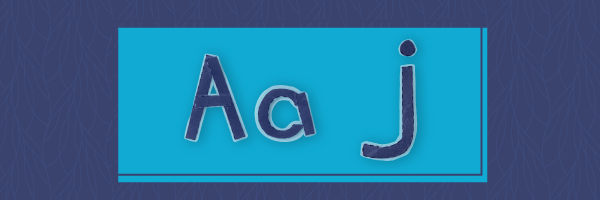
There are countless opportunities every day for you to point out letters in the books you read to your child or on signs and labels in your home or neighborhood. But you can also just whip out a sheet of paper or index card, write a letter on it, and talk to your child about it.
How to Talk about Letter Shapes, Names, and Sounds
It’s a surprisingly powerful literacy lesson just to say something as simple as This is the letter T. T says /t/ like in taco. T is made from one short line (trace across the top of the letter) and one long line (trace across the vertical line). In a matter of seconds, you’ve brought your child’s attention to a letter, given its name, highlighted its main sound, and traced its shape.
In fact, talking about letters may be one of the easiest and highest return-on-investment activities parents can do. Over time, these light touches will stick the ABCs in your child’s memory. You’ll build their knowledge of English’s 26 letters, the ways they combine to form 44 different speech sounds, and the 52 different ways we write them (uppercase and lowercase). And you’ll pave the way for them to sound out hundreds of thousands of words. It’s no wonder that letter knowledge at kindergarten entry is a significant predictor of reading skills down the road.
You can describe the lines and curves within the visual forms of letters, comparing and contrasting the shapes of different letters, for example comparing a lowercase “b” and “d.” You can write a “c” and draw a cat next to it, pointing out that the word begins with the /k/ sound. And so on.
I’m highlighting this kind of direct, straight-forward teaching of letters (individually, in isolation, and outside of words) because sometimes our preconceptions about what’s “natural,” “meaningful,” and “enjoyable” in young children’s learning get in the way of doing what’s effective and efficient.
A review of four randomized control trials of letter instruction for three- and four-year olds found that teaching letters on their own was more effective than teaching them while reading a book or within the context of words or names—and it was fun, engaging, and motivating to boot. Think about it: Letter lessons delivered during storybook reading have to compete with all the wonderful images and stories unfolding on the books’ pages.
That’s not to say that there’s no benefit to teaching letters within the context of books or everyday signage. In fact, you absolutely should do that, too. It’s just to say that it’s not the first or only way you should be teaching letters. It’s critical to teach literacy skills in meaningful contexts (in this case, within words) as well as in isolation. How else would kids learn what letters are for and how they connect with sounds and meaning? There are some books with large, bold letters and sparse illustrations that are perfect for drawing attention to print. They’re entertaining for kids and provide valuable prompts for parents to remember to talk about print. (More on this below.)
The point is: It’s best to teach letters in and out of context. Giving a specific lesson on a specific skill or a single letter isn’t tantamount to “drill and kill”—provided you keep it brief, light, playful, and responsive to your child. Key elements of education are practice, repetition, and “retrieval”—which is a fancy way of saying bringing knowledge up from memory—even with three-year-olds. So go ahead, give some five-minute direct letter lessons now and then.
It makes sense developmentally to start with uppercase printed letters, because they’re easier for kids to recognize than lowercase and handwritten letters.
A Simple Letter Lesson to Try
Just remember to keep it light and easy. You can create impactful letter experiences with young children in ten minutes or less. A home letter lesson, adapted from this instructional progression idea, might look like doing the following:
- Pick a letter.
- Write it on a piece of paper, say its name, and most common sound. This is the letter Z. Z says /z/.
- Describe its lines, curves and other distinctive features while pointing to or tracing them. Z is made of three lines. Two short and one long.
- Ask the child to trace and describe the featured letter parts one by one (e.g. lines, curves, dots). Can you trace the lines of the Z with your finger?
- Ask the child to write the key letter parts on whatever surface and whatever materials are handy (e.g. pencil on paper, shaving cream on the side of the bathtub, on the sidewalk with chalk). Can you draw one long and two short lines on this piece of paper?
- Ask the child to combine the features to form the letter. (Or, if their motor skills aren’t there yet, ask them to assemble the letter by combining letter-part cutouts.) Can you write a Z made of three lines?
This approach gives the child a bit of runway as they approach writing the letter. It gives them repeated opportunities to see the letter’s visual form while hearing its name and it breaks down the component features needed to write or build the letter.
How Kids Learn to Recognize and Distinguish Among Letters
As readers ourselves, parents often fail to grasp what a leap it is even to see letters as distinct from other images and graphics in print. To know an O from a circle or an H from a stick figure is the result of a long learning process, a slow-growing awareness of print and its properties. At first, pictures, letters, and numbers are all a bunch of 2D marks to be deciphered.
Children begin to be able to distinguish different things they see as infants. However, it takes years for them to develop the ability to differentiate letters from one another and from other letter-like forms. After all, all letters look very, very similar to one another when taken in the context of most other “objects” kids are learning to distinguish visually.
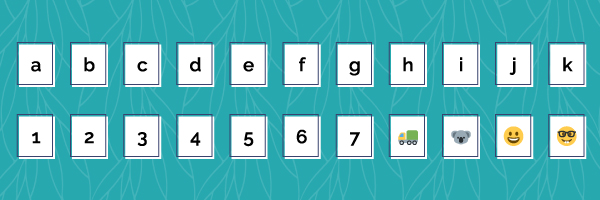
Eventually, they come to easily distinguish letters from numbers and other visual forms with letter-like shapes. They also tend to learn printed uppercase letters before lowercase letters and handwritten letters. As kids get older and gain more and more experience with letters in print, handwriting, cursive, and various fonts, their ability to discern letter variations and distortions grows. That is, they come to know that all of the following, despite different cases and fonts, are As.
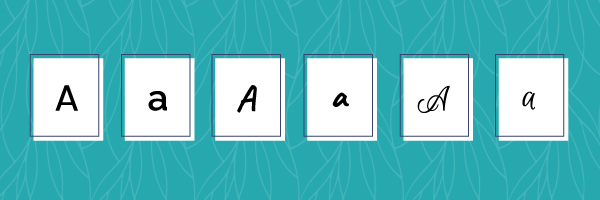
The sequence of letter-learning varies among children but, generally speaking, kids learn:
- Letters in their own names before other letters
- Uppercase letters before lowercase letters
- Printed letters before handwritten letters
- Letters early in the alphabet (A, B, C) before letters later in the alphabet
- The sounds for letters when the letter name gives a clue (“dee” for duck) before sounds for letters whose names don’t contain the letter sound (“double-u” for Wednesday)
- Sounds for letters with a single sound (e.g. /b/ for B) before sounds for letters with multiple sounds (e.g. /k/ and /s/ for C)
Teach & Practice the ABCs Through Play
As a parent teaching your child the alphabet, there are many different ways to deliver the letter lessons described above. You can point out letters as you play with alphabet blocks, write them for your child in glue or glitter, form them from playdough, and so on. Mixing the learning in to playtime with your child will keep it fun and engaging for them (and you).
Once your child is familiar with some letter names, shapes, and sounds, practice and repetition become especially important. It takes years to commit all those to memory, so finding fun games and crafts to reinforce the learning is powerful. Below are links to numerous activities you can do with your child to help them learn the names, shapes, and sounds of the ABCs.
Letter Name Games
Sure, you could hold up a card with a letter on it to find out what letter names your child knows. But if you call it a game of War and have them play against you, suddenly it’s transformed into something more lively and engaging. The same goes for naming letters on a board game, hopscotch squares, a soccer ball, or a scavenger hunt. Some letter-name practice is just more fun as your kids work to learn to correctly identify all 52 different uppercase and lowercase letters.
- Alphabet Game of War
- DIY Alphabet Board Game
- DIY Alphabet Fishing
- Alphabet Soccer
- Alphabet Hopscotch
- Outdoor ABC Scavenger Hunt
Letter Shape Activities
Nothing helps a child spend sustained time thinking about letter shapes better than an activity that gives them a chance to form a letter themselves. It also gets them in tune with the lines, curves, and intersections of letters even before they have the fine motor skills to write them with a skinny pencil. Give any or all of these activities a try to create fun time learning letters.
Letter Sound Play
I love The Name Game (Bananafana fofana fi fi fofana banana) for giving kids practice manipulating the sounds within words, attuning their ears to the different sounds that make up language—a crucial skill for later reading, writing, and spelling. But little ones also need to learn which sounds map to which written letters, and parents could use a slew of activities to provide that critical practice lightly over time.
- Wheel of Phonics
- Sound Search Game
- Pretend Alphabet Soup
- Alphabet Bingo
- All-Day Alphabet Scavenger Hunt
- Outdoor ABC Scavenger Hunt
- Alphabet Hopscotch
- Alphabet Soccer
- DIY Alphabet Board Game
- Alphabet Game of War
Seasonal Letter Fun
Getting your child’s attention is half the battle with anything you want to teach. And sometimes a seasonal hook is just the way to get your child in the letter-learning spirit. Here are some Thanksgiving, Halloween, Christmas, and Valentine’s Day activities to infuse a little learning into the holidays:
- DIY Turkey Letter Matching Game for Thanksgiving
- Christmas Alphabet Flipbook
- Halloween Alphabet Spinner
- Valentine’s Day ABC Memory Game
Tools for Teaching the Alphabet at Home
You can teach your child the letters of the alphabet with a little knowledge, a dab of confidence, your voice, and your pointer finger, for example using the scripts above. But using some external tools can help make the necessary practice and repetition more fun for them—and for you. Index cards, letter tiles, and alphabet books top my list of go-to tools, but there are lots of resources you can use to reinforce letter learning. Draw from the list below, and click on each tool to learn more and get inspiration for how to use it:
- Playdough
- Stacking Blocks
- Index Cards
- Letter tiles
- Comic Sans
- Craft Sticks
- Letter Tracing Sheets (free printable)
- Alphabet Books
Teaching with Alphabet Books
You can and should teach with whatever letters you find in your everyday environment, from the grocery store to the bus stop. But carefully curated books also create great opportunities to bring kids’ attention to print. And well-chosen alphabet books, in particular, can make letter teaching a snap for parents. Displaying quality ABC books in your home will create wonderful prompts to spend much-needed time engaged in letter talk with your child.
Numerous studies suggest that alphabet books prompt parents to talk about words, letters, and the writing system more than other kinds of picture books. While reading ABC books, parents naturally reference letters, count letters, separate words into individual sounds (also known as phonemes), and ask kids to do the same. All of this letter talk helps kids understand that printed text represents spoken language—and it builds their bank of letters and words they know.
When reading typical picture books, by contrast, parents are less likely to even draw kids’ attention to the print, much less to dig into the form, function, and features of written language. You’re understandably busy reading the story and talking about the book’s plot, illustrations, or connections between the story and the child’s life.
Don’t get me wrong: There is tremendous value to reading all genres of picture books, and those other kinds of read-alouds and conversations are crucial for developing vocabulary, comprehension, and book love. It’s just that when your aim is teaching letters, alphabet books are a wonderful choice. They make it easy to stay on task, provided you choose the right kind of ABC books.
Alphabet Teaching FAQs
At what age do kids need to know the alphabet, and when should parents start teaching them?
Kids should recognize all uppercase and lowercase letters of the alphabet by the end of kindergarten, according to the Common Core State Standards for English Language Arts. So the question is: What should parents do when their kids are infants, toddlers, or preschoolers to help them meet that expectation? When should letter instruction begin? How should it progress as children grow?
If books and reading aloud are a part of your family life beginning in your child’s infancy, your child may begin to gain awareness of printed letters before their second birthday. For example, the Texas Infant, Toddler, and Three-Year-Old Early Learning Guidelines state that toddlers (18-36 months old) might recognize some letters with help, such as their own first initial.
“Help” is an adult drawing attention to the child’s name, for example, showing a monogrammed blanket and saying “Z says /z/. Z-O-R-A says Zora,” as they point to each letter in turn. Helping your child make the connection that a printed shape corresponds with a particular sound can be just as simple as repeating short sentences like that now and then—again and again over the days, weeks, and months of early childhood.
After three years old, kids’ letter-learning capacity noticeably expands. Between 36 and 48 months old, children might identify some letters, know the sounds some of them make, write letter-like forms, and even grasp that letters combine to make words, the Texas guidelines say. Some research suggests that three-year-olds can learn as much about the alphabet as four-year-olds. And about half of four-year-olds recognize their own first initial and can name some printed letters. Of course, fulfilling that potential depends on the visual experiences with print, and conversations around print, that young children have with the adults in their lives. So ramp up your letter teaching when your child is about three.
Formal letter instruction typically accelerates in the preschool and pre-K years. But the federal and state standards that early educators use to guide instruction vary widely in terms of how many letters they say kids need to know and by when. For example, South Dakota’s benchmarks expect that an older preschooler (45 to 60+ months) can “recognize and name at least half of both upper and lowercase letters of the alphabet.” In Texas benchmarks, by contrast, a child is considered on track at the end of preschool if they can “name at least 20 upper and at least 20 lowercase letters in the language of instruction.”
I say, aim to give your child rich lessons in letter names before kindergarten, because you don’t know which letters your particular child will pick up right away and which will take them more time to learn. Your child may even master them all, paving the way for more advanced literacy lessons come kindergarten.
Is it pushing kids too far, too fast to teach them the ABCs so young?
No. The timing of letter-learning matters because the number of letter names kids know at kindergarten entry predicts their later success in reading and spelling. And that’s independent of the child’s age, socioeconomic status, IQ, and other early literacy skills, according to the National Early Literacy Panel.
Evidence supports aiming for kids to learn 18 uppercase letter names and 15 lowercase letter names by kindergarten, say researchers who study the relationship between preschool learning and later academic outcomes. In other words, kids are fully capable of knowing that many letters at kindergarten entry (with our help), and those who do are more likely to succeed in the classroom.
Some parents may object to directly teaching letters to three-year-olds—and to the notion that kids should know the whole alphabet by the end of kindergarten—on the grounds that they learned their letters later in life, and they read fine.
The problem with that thinking is that, rightly or wrongly, U.S. elementary-school standards are much higher today. And children who don’t know enough letters when they start kindergarten are likely to struggle to grasp classroom instruction, fall further behind peers, and experience feelings of anxiety and inadequacy.
Other parents point to the reading success of students taught in traditions that don’t even commence reading instruction until kids are seven years old—such as in Waldorf schools or in Finland. But we don’t know how much letter experience those children receive outside of school, and not teaching your child letters before kindergarten is ill-advised for parents who plan to enroll kids in traditional U.S. schools that teach reading sooner.
Letters are the building blocks of the words that kids must learn to read, and in most U.S. schools, letter names are the very “language of instruction,” researchers have observed. Sit in on a typical kindergarten class and at some point you’re likely to hear phrases such as the following, they note:
- “How do you spell cat? C-A-T.”
- “What’s the first letter of that word? A!”
- “What letter makes the /m/ sound? That’s right, M makes the /m/ sound.”
To make sense of questions like those above, students in traditional U.S. kindergarten classrooms need to know a good deal of letter names and have a sense of the function letters serve in words. Children who don’t know letter names can’t engage in the crucial conversations about reading and writing that they’re meant to learn from.
The main reason for U.S. parents to build alphabetic knowledge early isn’t that it’s impossible for kids to learn it later, but that our current system of education offers insufficient support for kids on that path. Most U.S. schools simply are not equipped to meet kids where they are. They’re set up to teach particular content at particular grade levels, and if your child isn’t there—good luck. Moreover, as children advance through the grades, their access to foundational reading instruction and effective intervention declines.
Simply put, parents need to prepare their children to thrive in the system they’ll be enrolling in. If your child is going to be traditionally schooled in the U.S., they need to be ready to navigate the customs, curriculum, and expectations found there. The good news is that any caregiver with even basic literacy, few to no materials, and just minutes a day can get them ready—with the right knowledge and approach.
Should you teach letter names first or should you teach letter sounds first?
It’s fine to start by teaching letter names, as most U.S. parents do, or by teaching letter sounds first, as most UK parents do. But for simplicity’s sake, I recommend teaching them together. Kids ultimately need to know both, and research shows that teaching letter names and sounds at the same time doesn’t confuse kids or over-burden their memory.
Letter names give young children the labels they need to make the different manifestations of a letter stick together in their memory—upper- or lowercase, print or cursive, one font or another.
And because many letter names bear some resemblance to their letter sounds (B says /b/, for example), little ones who have learned letter names have a tool for grasping and remembering the letter sounds they must learn in order to read.
When we talk about learning letter sounds, it’s important to note that there are really two things kids must grasp to know the sounds of the alphabet. The first is just learning to discern the individual speech sounds we hear in words (this ability is called phonemic awareness). The second is learning that letters represent those sounds. It’s a watershed moment when kids grasp the connection between printed letters and the sounds that make up words (known as the alphabetic principle). Suddenly, they are ready to start sounding out words in print.
Fun fact: There’s also evidence from research that the hand movement involved in writing letters is correlated with letter-naming fluency and solidifies letter-sound matches. That means all of your letter work is interrelated and mutually reinforcing.
How do I know if my child is on track with learning the alphabet?
You can do an informal assessment of your child’s letter-name knowledge by writing uppercase and lowercase letters on separate index cards, showing them in a random order, and asking your child to name them. Then record the date and whether they responded correctly or not on the back of each card. If the response surprises you or is noteworthy in some respect, jot that down on the back of the card as well.
These casual notes about what your child knows, and when, will prove invaluable as they move towards reading. This kind of simple assessment is the basic method that many literacy researchers use.
Just keep in mind that you are a parent and not an official testing agency with rigid protocols to follow, so it’s best to keep your letter assessments light and fun as well. You don’t have to assess all 26 letters in one sitting. Try doing a few at a time. Then do a few different ones the next week. If your child seems to enjoy the exercise, though, go ahead and run through as many as they have the interest and patience for.
If you have concerns about your child’s progress or just want a second opinion, it’s also a great idea to inquire about an “emergent literacy screening” when your child is preschool- aged. Check with your local school system or municipality for details. For example, in Wisconsin, where I live, the state requires each school district and charter school to assess all early-elementaryeach students for reading readiness annually, starting at four years old. Moreover, by law, the district must share the results of the reading readiness assessment with parents and provide interventions or remedial services if the child is at risk of reading difficulty.
It’s also important to get help if you’re not sure your child is progressing as they should. Many children who may seem to be lagging can make great strides with a bit of outside instruction. Some don’t, though, and it’s important to figure out early if your child is at risk for potential reading difficulty and needs more intensive early intervention.
Now that you know what your child needs to learn about letters and when, check out our literacy activities for hands-on ways to add alphabet play to your day.
And the fact is teaching letters should be every parent’s aim, and staying on task with it is a game-changer. That’s because relying on school alone to teach kids their ABCs is a losing strategy. One study of 81 preschool classrooms found the teachers spent an average of just 2.77 minutes a day teaching letters. The rest of the time they focused on other important self-care, social-emotional, and pre-academic skills. Imagine how easily you could double that time at home and target the lessons to your child’s level.
What questions do you have about teaching your child the ABCs? Let us know on our socials or email hello@mayasmart.com. We’ll respond with research-based answers and resources.
Robocalls. Emails. Texts. Newsletters. Fliers. Communications from schools to parents have got to be at an all-time high. There’s been an explosion in the methods teachers, administrators, and volunteers use to keep parents informed. At various points in my daughter’s school career, I’ve had to check emails, text messages, apps, websites, and even social media to stay on top of school information. Not to mention all the paper assignments, permission slips, newsletters, and notices that still make their way home via her backpack and snail mail.
Beyond the number of communication channels, the sheer volume of news and information to contend with has exploded. COVID-19 has meant streams of updates regarding vaccinations, outbreaks, and testing … on top of the typical messages about homework, field trips, picture day, and parent-teacher conferences. It also means that missing school communications carries greater implications for our families’ health, safety, and social-emotional wellbeing than ever before.
I had to chuckle recently when I received an email with the subject line “Recorder Masks Coming Home to Wash!” from my daughter’s music teacher. Never in a million years would I have anticipated that washing and returning a mask for a musical instrument would be among the 85 million tasks on my to-do list. But such is life these days.
It’s our job as parents to read it all (okay, skim it) or risk missing something important. How else will we know when testing days, class trips, and other special events are coming up? Or how many kids and teachers are in isolation or quarantine this week? Or what the signup deadline is for the latest, greatest enrichment program? Or when the Monster Bash Bag donation is due to the PTO?
Here are the three things that I’ve found indispensable for helping me successfully navigate the geyser of school information for the benefit of my sanity and my child’s life and education.
List School Communication Channels
I know what you’re thinking: that sounds like work. But this is quick work with a MAJOR return on investment.
Seriously, take a deep breath, sit down, and write out a list of all of the ways your child’s school or teacher is communicating with you. If you have multiple children, make a list for each one. You can brainstorm quickly on paper or in the Notes app on your phone to get going.
Importantly, for each channel, jot down whether the school automatically pushes notifications to you (e.g. an email or a text) or if you have to proactively go to the source (like the school website or a classroom Facebook group).
This is a simple yet powerful exercise for getting a handle on all the education information flowing your way about your child. It will help you make decisions about which matter most and how to engage with each. Making this list can be especially eye-opening for parents with multiple children at different schools.
I’ve noted some types of communications below, but on your list be sure to include individual sources within categories separately. For example, treat text messages directly from a teacher and mass texts from the school as separate channels. This hones your sense of who exactly is sending you what, and the frequency and relevance of what you’re getting.
Sample School Communication Channels
- Email (e.g. individual messages from teachers or administrators, mass messages from the school or school district)
- Text messages (e.g. individual messages from teachers, mass texts from the school)
- Facebook (e.g. public school page, private classroom page)
- Phone calls
- Website (e.g. school website, district site, school information and learning management system like Infinite Campus, JupiterEd, PowerSchool, and Google Classroom)
- Mobile app (e.g. Where’s the Bus, Rallyhood, and Remind)
- Postal mail (e.g. school, district, and PTO newsletters)
- Student take-home folder
If you make this list digitally, add in links to the relevant sites for easy reference later. You could also go ahead and bookmark them in your browser.
Make Crucial Information Highly Visible and Easily Accessible
Now that you’ve identified where all the information is coming from, it’s time to make sure that the important stuff gets your attention. This requires offense and defense—proactively highlighting the good stuff and filtering out distractions.
As Greg McKeown reminds us in Essentialism, “Almost everything is noise, and a very few things are exceptionally valuable. This is the justification for taking time to figure out what is most important. Because some things are so much more important, the effort in finding those things is worth it.”
Create Inbox Filters to Highlight School Communications
Email filters and labels are magical. They allow you to highlight messages from the people who matter most. I know that anything coming to my inbox from a teacher, school, or district is worth a look, so I set up a Gmail filter to star anything with our school district’s domain name in it (e.g. districtname.org) and to add a label with her school’s name to it as well. I also set up filters for sources that come from other relevant domains, such as the school’s info management system or individual parent volunteers who email from their personal accounts.
Banish Noise Automatically
Highlighting important emails is one thing, but if your inbox is overflowing with clutter, even that may not be enough to help school communications stand out.
A pro move I recommend is using a service like SaneBox to filter out the fluff of newsletters, product updates, receipts, and other non-urgent items. These notices aren’t spam if you signed up for them, but they are incredibly distracting and not a top inbox priority. By automatically filtering them into a special news label or folder, you can scroll through them all at once at a convenient time.
I used to try to do this manually or rely on Gmail’s own Priority Inbox feature, but SaneBox is much better. Its algorithm pulls this stuff out of your inbox for you and sets it aside in a folder that will be there whenever you’re ready. It also gets smarter, personalizing how it files emails based on which emails I open and how quickly or frequently I reply. Plus, it also works across devices (e.g. desktop or mobile) or email client (e.g. Gmail or Outlook). You can set up your own filters and rules with SaneBox, but I haven’t needed to. Its algorithm is that good.
Set Reminders to Check Sites or Sources that Don’t Push Notifications to You
There’s some school information that you may care about that’s not sent directly to you. For example, my daughter’s district no longer emails weekly COVID-19 quarantine and isolation reports to families. Instead, you have to go to the district website to view the pandemic data dashboard.
In instances like these, you’ve got to set your own reminder to go get the information at a specific recurring date and time (that’s convenient for you). Otherwise, it’s out of sight and out of mind.
Digital reminders are great for this. You could add an appointment on your calendar, put it in your to-do app with a deadline, or set up a recurring weekly email or text reminder.
Personally, I prefer text reminders for things that can be handled quickly on my phone, email reminders for things that I need to do at my desk, and calendar appointments for things that take 30 minutes or more to handle. I use SMS by Zapier to send myself recurring texts, Zapier’s Gmail integration to send recurring emails, and Google Calendar for appointments (even those I make with myself).
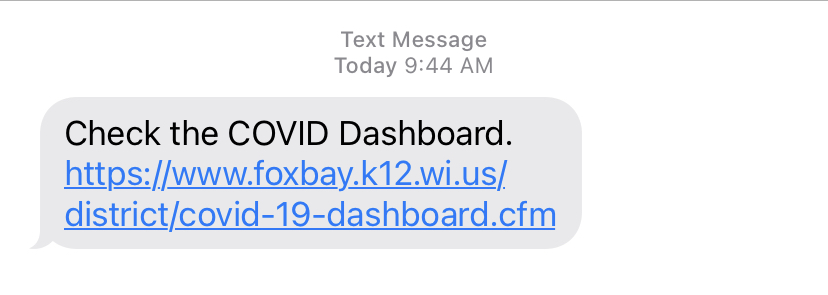
Find a home for the information that matters.
Although they vary dramatically in delivery mode, school communications generally fall into six buckets: Events and appointments; student work; requests; health/safety/emergency; news and announcements; and reference materials.
Regardless of how you receive the information, by text, newsletter, or carrier pigeon, it’s up to you to decide what to do with it. Letting it languish in your inbox isn’t an option, so you’ve got to develop the discipline to pull out the relevant details and put them in a predetermined spot for later reference.
Sample School Information Landing Spots
Events and appointments —-> Calendar
If there’s a day or time involved, you know it needs a spot on your calendar. My Google Calendar is the single source of truth re: school dates, but we also keep a large paper calendar on the kitchen counter so everyone (my daughter included) can stay on the same page.
- Field trips
- Testing days
- Performances
- Themed-dress days
- Picture day
- Vacation dates and school closures
- School info night
- Parent-teacher conferences
Student Work ——> Trash, Reference File
The take-home folder is the source for reams of artwork, completed worksheets, and compositions. I file it all into a plastic bin labeled with the school year on the side. After the school year ends, I’ll go through it with Zora and we’ll pull out the best stuff for longer-term storage. We may keep the paper copies in some instances, but often the best long-term storage space is digital. Scanning or photographing select items means you can keep the memory without adding to physical clutter. The rest gets recycled or discarded.
- Assignments
- Art projects
Requests —-> Calendar, To-Do List
Schools ask a lot of parents because we’re an integral part of our kids’ education and the learning communities that they’re part of. When requests come in, we should strive to respond quickly—yay or nay. If it’s a yes for us, getting time-sensitive events and deadlines on the calendar is critical, as is returning permission slips and feedback forms. If we commit to selling raffle tickets or other tasks, we need reliable systems for reminding ourselves to get those things done. (See the earlier note about digital alerts to self.)
- Fundraising (e.g. join the PTA/PTO, buy raffle or event tickets)
- Volunteering (e.g. prepping classroom materials, chaperoning a field trip)
- Information (e.g. surveys, forms)
- Permission (e.g. for field trips or COVID testing)
Health, safety, weather, and emergency announcements —-> Calendar, To-Do List, Reference File
This is a critical category of information that sometimes gets lost in the shuffle. Think of the flu vaccination reminder buried on page 12 of the district newsletter. When you come across this kind of thing, make a habit of getting the appointment or action item into your calendar or to-do list right away. You don’t need to keep the whole newsletter. Rather, you need to pull out the actionable nuggets and … take action!
- Flu vaccination reminders
- COVID close contacts and outbreak updates
- Anonymous safety report form
- Weather updates (e.g. wind chill warnings, snow accumulation)
- School closing, early releases, and late starts
News and announcements —->Trash, Reference File
Scan newsletters and articles to stay on top of new developments, but don’t hesitate to trash or recycle them afterward. Most of the content here is strictly FYI and there’s no particular action for you to take as a result. If there is, remember to pull out the details and get them on your calendar or to-do list. You don’t need to save the whole document!
- Staff changes
- Curriculum changes
- Facilities upgrades
- Event or lesson recaps
- Awards and recognition
Reference Materials —> Trash, Reference Files
This category includes things that you are likely to refer to frequently throughout the year yourself or that you need to have on hand to share with other caregivers. I store reference documents in a folder on my kitchen counter and in a photo album on my phone for access on the go.
- School year calendar
- Bus route details
- Carpool lineup instructions
- Staff or family directories
- Home health screening checklists
- Backpack packing checklists
Fully acknowledging the flood of information you receive from schools is the first step toward wrangling it. From there you can make conscious choices about what matters most and what you’re going to do to make sure you see and act on that information in a timely fashion. Finally, predetermining where you’re going to file the rest of the details is critical for the processing speed. Your calendar, reference files, and to-do lists are great destinations. So, too, is the trash.
Have you noticed an uptick in school communications? How are you handling the information load? Will you try any of the tips above?
Fact: fiction is good for you. So, while it may be tempting to see nonfiction as a somehow more “useful” reading choice, if your child makes a beeline for tales, fables, and all things kid lit (as my four-year-old has done from the get-go), rest easy. Put any worries over fiction vs nonfiction to one side, and instead look for a mix of books that interest your child. One of the best things a parent can do to motivate their child’s learning and development is to follow their reading interests, no matter the format.
What’s more, there are some great reasons why kids should read fiction. Science is now backing up what story lovers have long held true—that fiction brings a host of benefits to readers. Not only does it appear to spark joy, help with relaxation, broaden horizons, and deepen focus, but researchers are discovering that it has an important role to play in other areas too.
Fiction nurtures emotional intelligence, open-mindedness, and altruism
Can reading literature really foster empathy and open minds? Yes, according to a wealth of research over the last two decades. A high “EQ,” or emotional intelligence, is a crucial element of general intelligence, and a key predictor for thriving in life—as highlighted by psychologists John Mayer, Peter Salovey, and Daniel Goleman. It’s as important as IQ, if not more so. And one of the benefits of reading fiction is its positive effect on personal growth and EQ. Studies have shown it fosters:
- Theory of mind—the ability to think about the mental states of others, as well as our own
- Empathy—the capacity to understand and share another’s feelings
- Social cognition—the ability to interpret social information and use it to guide behavior
- Open-mindedness—an attitude necessary for both reasoning and creativity, and a characteristic of high EQ
- Altruism—for example, fiction readers are nearly three times more likely to volunteer than non-readers, independent of education level, age, gender, or ethnicity
Stories are training for real life
Keith Oatley, professor emeritus of cognitive psychology at the University of Toronto, has dug deep into how reading fiction—and the exercise in relating to the perspectives of characters it encourages—can act as a kind of training for real life, specifically our social world.
In his words, fiction is a “particularly useful simulation because negotiating the social world effectively is extremely tricky, requiring us to weigh up myriad interacting instances of cause and effect. Just as computer simulations can help us get to grips with complex problems such as flying … so novels, stories, and dramas can help us understand the complexities of social life.”
Give children access to fiction books, and you can help them learn nuanced lessons about how our societies and communities work.
Literature stimulates language learning
Curious to know what’s going on in your (or your child’s) brain when you read fictional stories?
Researchers in one study took functional MRI scans of several fiction readers’ brains. One finding was that even on the mornings after reading, brain activity was heightened in the left temporal cortex, an area associated with receptivity for language. According to neuroscientist Gregory Berns, such heightened brain connectivity is what experts call “‘shadow activity,’ almost like a muscle memory.”
A 2021 study on reading for pleasure also found that people who read fiction, regardless of its perceived “quality,” have better verbal abilities than those who don’t. If one of the possible benefits of reading fiction—any kind of fiction—is that it flexes the language “muscle,” let’s follow our kids’ interests and give them plenty of room to flex!
Narratives boost comprehension and problem-solving
A skill called “sequencing” is another great argument in favor of why kids should read fiction. Sequencing is being able to identify, organize, and re-tell the order in which events happen, e.g. the beginning, middle, and end of a narrative—and having a good handle on it is a key reading comprehension skill.
Beyond reading, it also plays a huge part in the “step-by-step” of our daily activities, from morning routines to following recipes. Being able to understand and organize information logically through sequencing aids problem-solving across subjects, from math to history, too. So it stands to reason that reading, listening to, and talking about stories (as well as narrative nonfiction) are brilliant ways to strengthen this vital skill.
Tales supercharge reading skills
According to some literacy research, the mix of what a person reads can make a difference to their skills. A study of over 250,000 teenagers’ reading habits across 35 countries found that those who read fiction several times a week had reading scores almost six months ahead of those who rarely or never read fiction.
And this “fiction effect” on reading proficiency held true even when other factors had been taken into account, such as the fact that fiction readers tend to spend more time reading than nonfiction readers. While reading nonfiction also has demonstrable benefits, it’s great to know that stories can be so powerful for developing excellent literacy.
The bottom line: Don’t frame your family reading choices as “fiction vs nonfiction,” but rather as “fiction and nonfiction.” All informed by your child’s personal interests and inclinations.
Are your kids fiction fans? What kinds of stories do they pick out? And what benefits of reading fiction have you noticed?
The winter holidays are often marked by delicious treats and cooking traditions passed down from generation to generation. By sparkly decorations hanging from trees, windows, and fireplaces. And, all too often, by frantic holiday shopping for relatives, teachers, and neighbors.
This holiday season, combine time together in the kitchen with a little light reading practice with your kiddo … all while creating some adorable decorations that also happen to make sweet gifts.
These simple, DIY Christmas ornaments require only two ingredients (applesauce and cinnamon) and very little prep work. They do take a while to cook, so a little patience will come in handy.
In the end, you’ll have festive homemade decorations or gifts that your child made from start to finish. Plus, they smell wonderful! This recipe makes about 15 ornaments, depending on the size of cookie cutters you use.
You can also use this recipe to show your child the different sounds the letter C can make. Print the recipe and ask your child to circle every word they can find with a C in it. Then help them read the words. Point out that the letter most often makes the hard C sound, as in cut, but that it can also make a soft /s/ sound, as in cinnamon or applesauce.
Note that the hard C sound at the beginning of Christmas is an exception from the usual CH sound. You can just help your child read the word without getting into the CH pattern and exception. (If they’re curious and ask about it, explain that some words are pronounced differently than they look, often because of the way spelling and accents evolved over time.)
Then let your child take the lead on reading the instructions, to the best of their ability. If they struggle to read some of the longer words, cover part of the word and see if they can figure it out in segments, like “apple” and “sauce,” and then put them together. Most of all, keep it fun!
This Christmas ornament recipe is part of our Read with Me Recipe series of printable recipes that are super easy to make—and, crucially, read—with children. They feature simple words and short sentences typed in an easy font that will set your little one up for reading success.
Just print out the recipe and then read it with your child as you cook together. (Scroll down for tips on using it to help teach reading.) The idea is to make it easy for you to mix reading and writing into everyday life with your kids. This kind of “everyday literacy” is key to raising thriving readers.
Tips for teaching kids to read with this recipe:
- Introduce your child to how recipes work. If you’re not sure they know them already, be sure to explain vocabulary like “ingredients” and other cooking terms. (Even though we won’t be reading such complicated words in this recipe, they’re important words to learn.) One of the biggest challenges for beginning readers—and most important oral language underpinnings of literacy—is just knowing and understanding all the words they’ll encounter in print.
- Watch out for specific words in the recipe they may not be familiar with (possibly “cinnamon” in this recipe), and give a simple definition.
- Keep an eye out for tricky-to-read words, such as “hours.”
- For little ones who aren’t reading much yet, just pointing out what you’re reading and emphasizing a few key words or letters is enough. If you make the recipe again, you can help them find the words you pointed out before.
- Use this as an opportunity to show them punctuation, as well as words and letters. Point to the commas, periods, or other punctuation marks, and explain what they mean.
- If they can’t read the recipe on their own, give them chances for success by asking them about what they do know, gently underscoring key knowledge. E.g., ask, Can you find a letter T? or What letter does this word start with?
- For kids who are reading already, encourage them to read the recipe themselves. If they have trouble, just calmly help them with any words they can’t quite get. E.g., if they have trouble with the word “applesauce,” try covering “sauce” and helping them read just the first part of the word before you uncover the rest.
- Bring your patience. Give your child space to read a word (or identify a letter) before you jump in, but be prepared to help if they’re showing signs of frustration.
Related: View and print our other Read with Me Recipes.
Applesauce Cinnamon DIY Christmas Ornaments
Notes: These ornaments are not edible, so avoid letting children eat the dough.
Also, the recipe involves using a hot oven and isn’t appropriate for young children to complete alone. Adults should help with baking the ornaments.
- 2 cups applesauce
- 2 cups cinnamon
- Straw
- String
- Cookie cutters

Step 1: Heat the oven to 200 F.
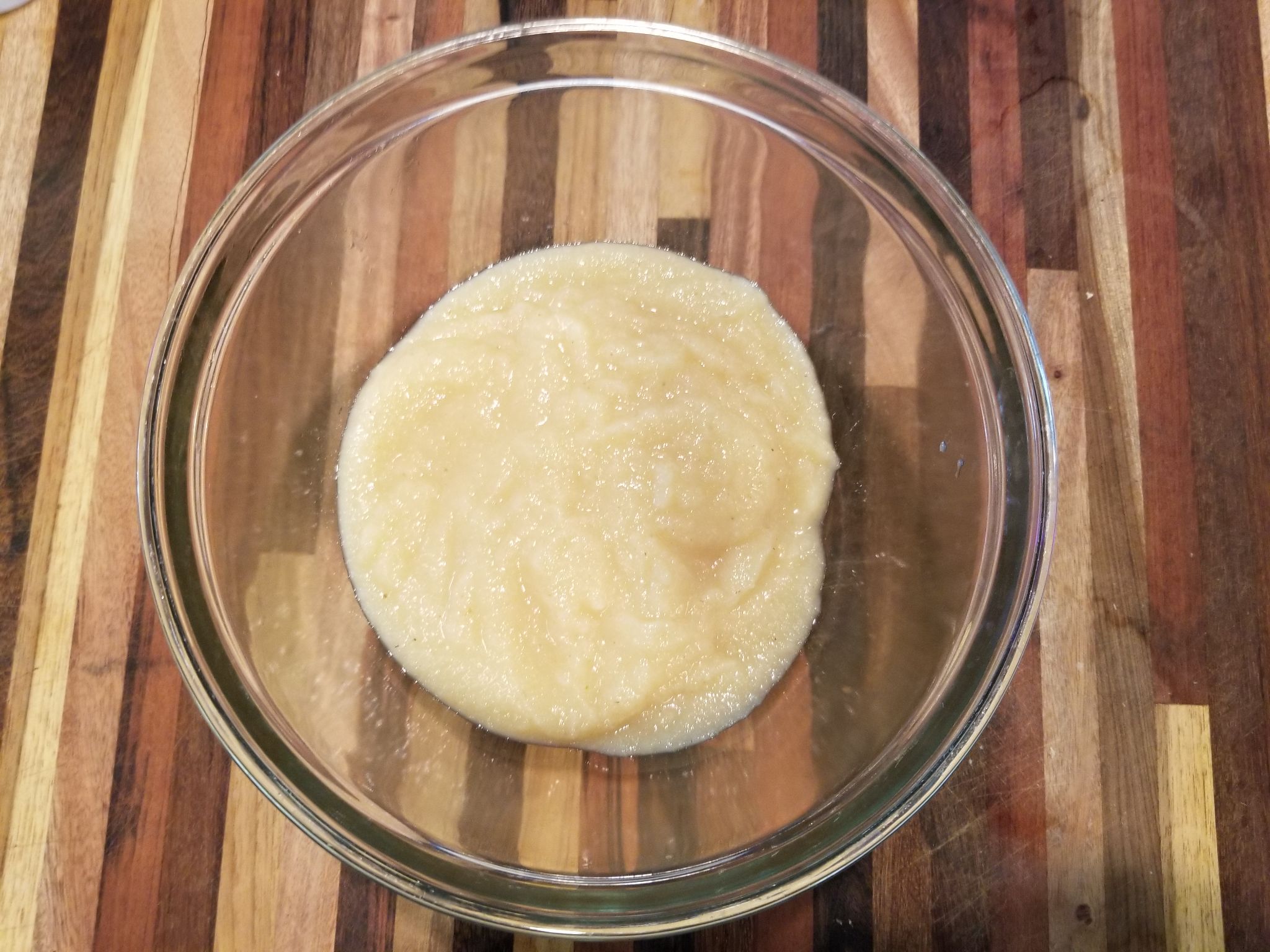
Step 2: Put 2 cups of applesauce in a bowl.
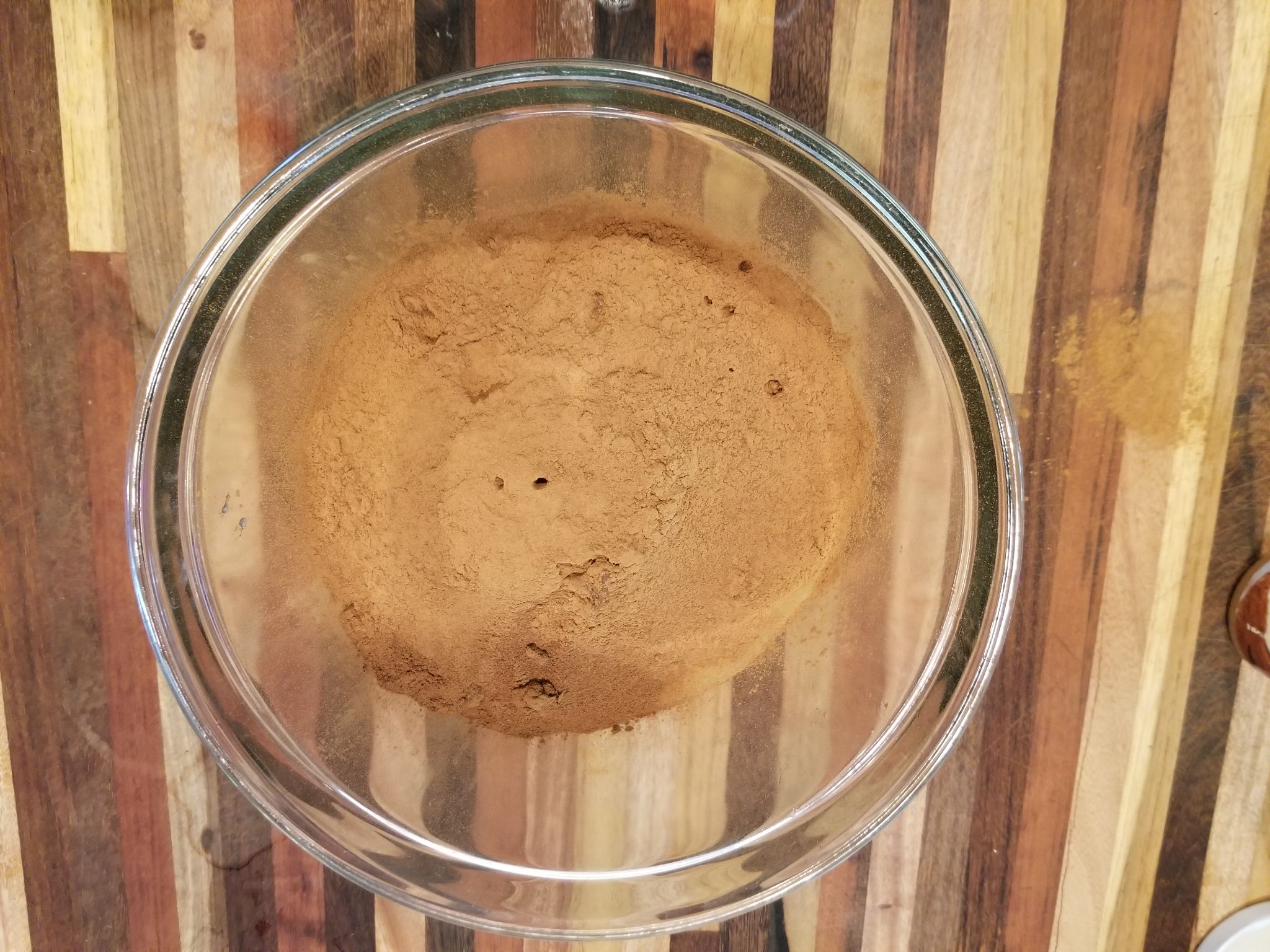
Step 3: Add 2 cups of cinnamon.
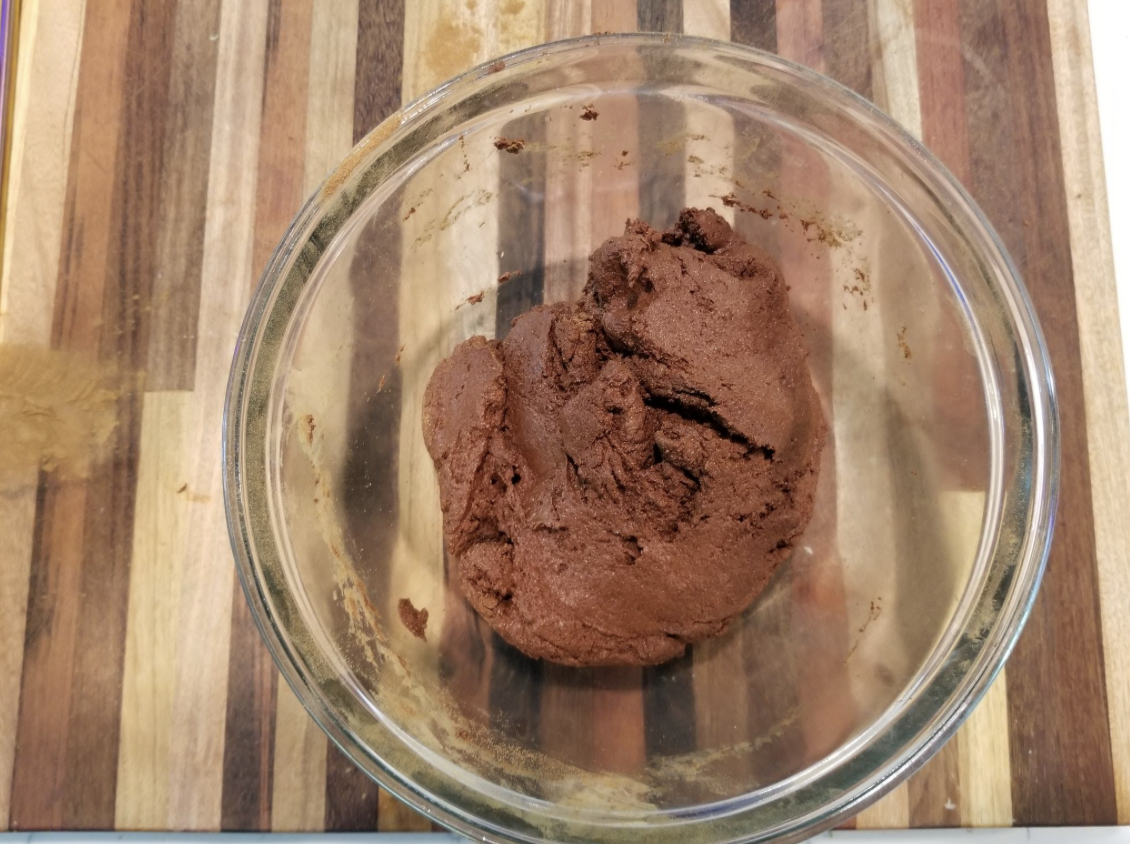
Step 4: Mix it. Form it into a thick ball.
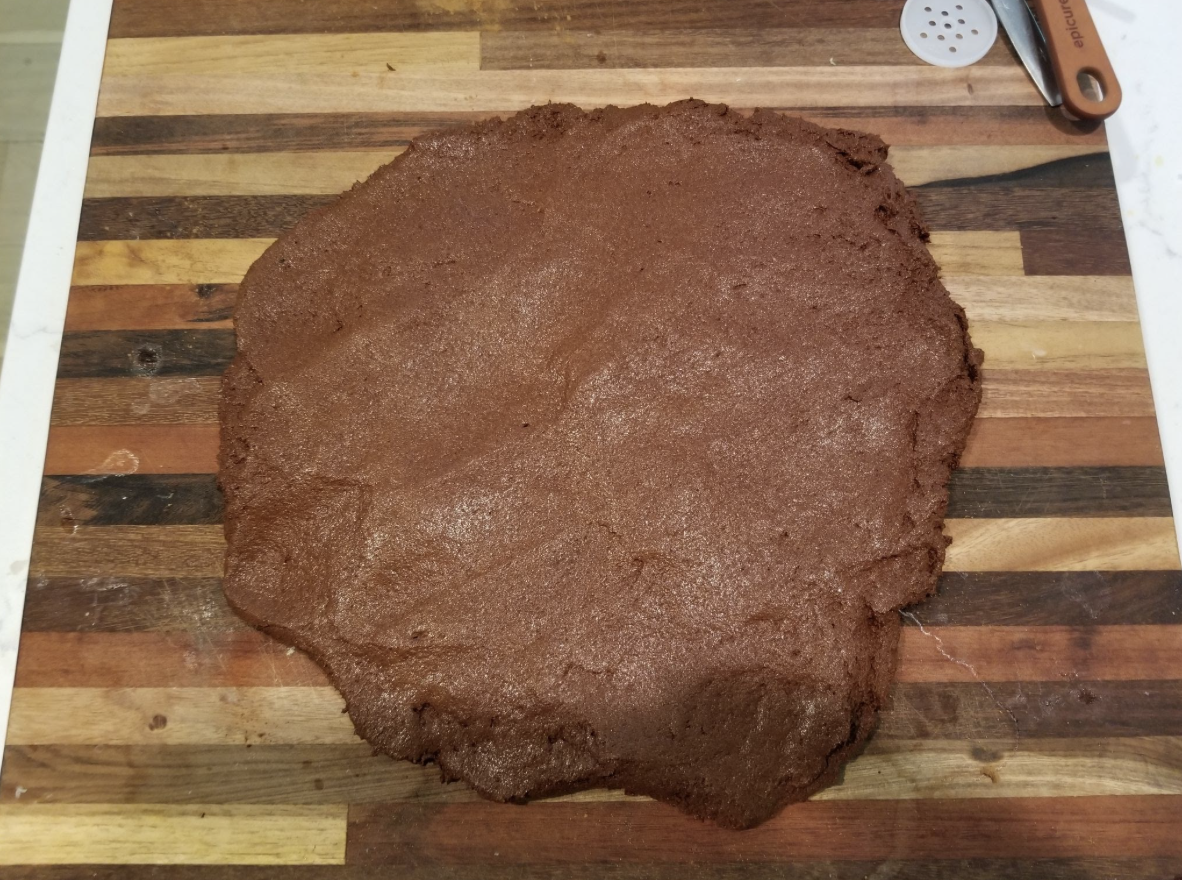
Step 5: Pat it flat.
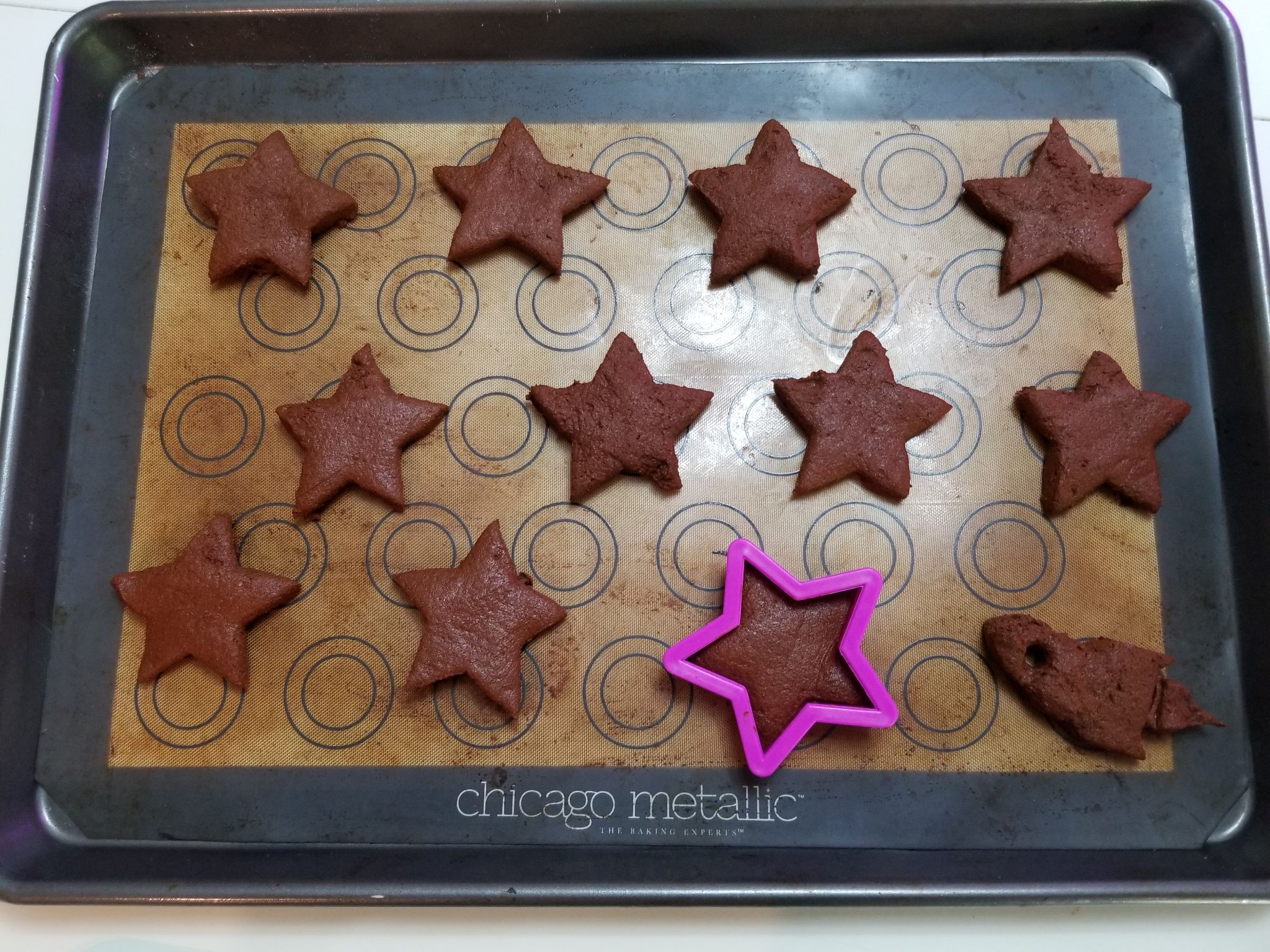
Step 6: Cut out shapes. Put them on a baking sheet.
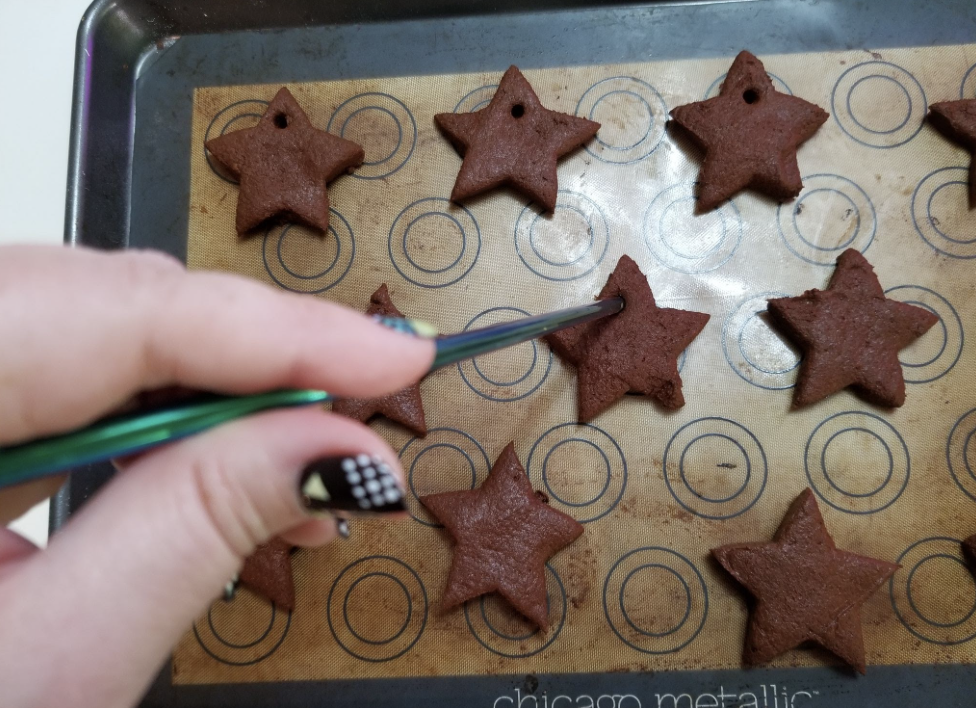
Step 7: Make a hole at the top with a straw.
Step 8: Put them in the oven. Bake for 2 hours.
Step 9: Take them out and let them cool.
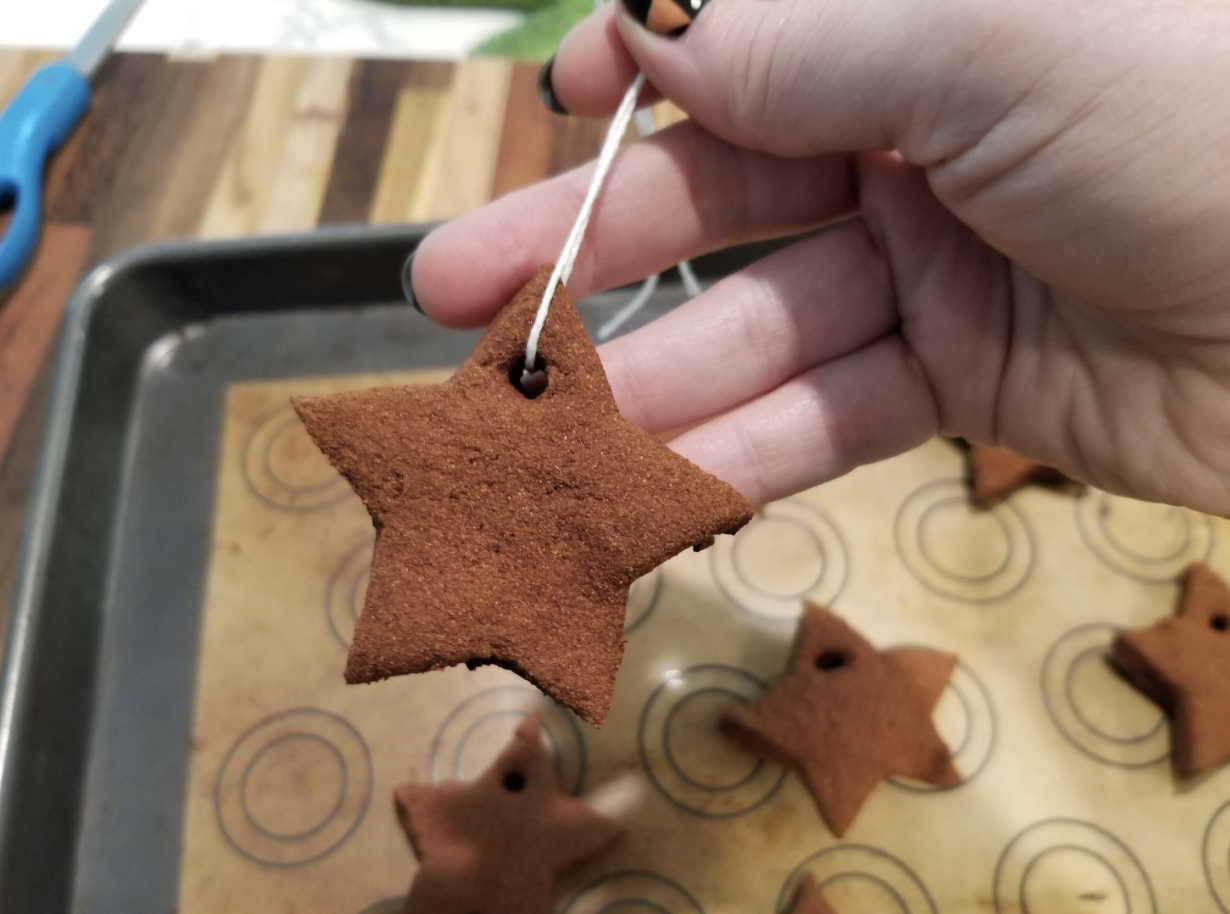
Step 10: Put strings in the holes and hang them up!
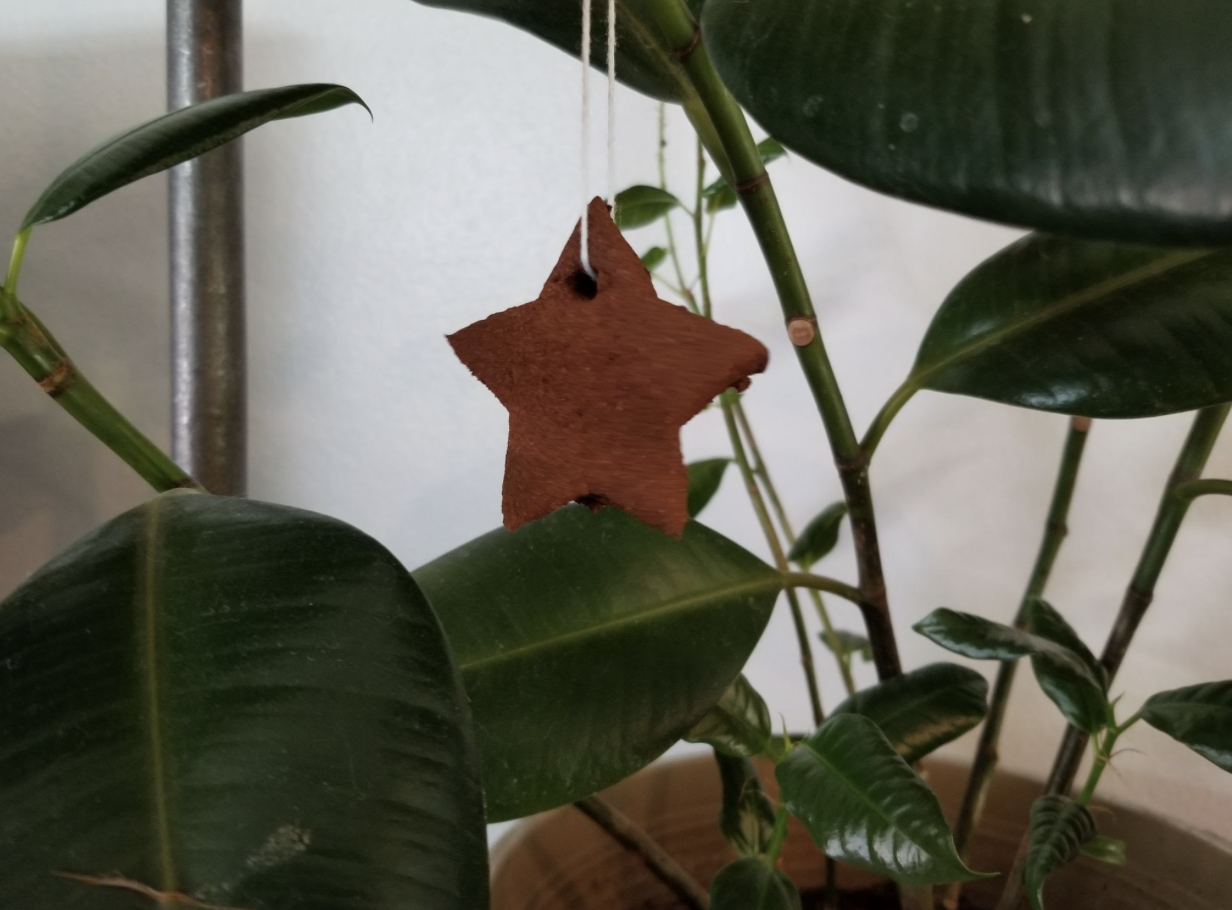
Enjoy!
Tempted to write off empathy as a “soft” skill? Think again. Today, understanding and being sensitive to others’ feelings and perspectives is seen as a new “superpower” across fields from education and business to science and technology. And it’s credited with everything from increased personal satisfaction and creativity to better leadership and negotiation skills. As Barack Obama put it, “Empathy is a quality of character that can change the world.”
But empathy is on the decline. The U.S. is suffering from an “empathy deficit,” according to researchers. In 2009, American college students were found to be less empathic than 75 percent of those 30 years earlier (and the jury’s out on whether things have improved since). It appears that as a society we’re becoming more narrow-minded, more disconnected. Yet only around 10 percent of our ability to empathize actually comes down to genetics, while making a habit of it—for example practicing loving-kindness meditation—can make our brains grow. Knowing all this, perhaps there’s a case for including empathy in school curriculum, as Denmark has done since 1993.
Want to nurture empathy? Love literature? You’re in luck. According to experts and organizations such as Empathy Lab, reading fiction increases empathy. But how does immersing yourself in a story help make you a better person? And how might this be relevant for your child and your family’s reading choices?
In this article, we take a look at the research, and how—among many other benefits—fiction helps us and our children to develop emotional intelligence.
Fiction Helps Kids Understand Other People’s Points of View
In psychology, Theory of Mind is the term for the ability to understand and think about what another person is thinking and feeling—a kind of “mind-reading,” albeit one most of us practice regularly. A skill closely associated with empathy, it truly starts to emerge in children around age four or five. The good news for little fiction readers? One study has found that preschoolers who are exposed to storybooks are better at it. And another found that the more often children read picture books with their parents, the better their theory-of-mind development.
This link between reading fiction and theory-of-mind is supported by research in adults, too. In one study, fiction readers were found to perform better across a range of social intelligence and theory-of-mind tests, such as the “Mind in the Eyes” test, where participants have to correctly identify complex emotions by looking at photographs of people’s eyes.
But, when it comes to being able to understand what’s going on in other people’s heads, does the kind of fiction you read make a difference? Some evidence suggests so. One landmark study of five experiments shows that adult readers of literary fiction—which tends to be more character-focused, psychologically complex, and ambiguous than other forms—possess greater theory-of-mind abilities than those reading nonfiction, popular fiction, or nothing.
Fiction Lets Kids Feel What Others Feel
Understanding how others may feel at a rational level, known as cognitive empathy, is one thing. But being able to identify with their feelings, at least to some extent, is what takes emotional intelligence (often shorthanded as “EQ”) to the next level. And this is where the ideas that reading fiction can foster empathy—and that it’s possible to harness that empathic uptick to create positive social change—come into their own. For example, some research shows that those who are most emotionally transported by a story are also the ones most likely to behave in a more empathic and pro-social manner.
As with the research connecting reading fiction and theory-of-mind, some studies have found that it’s the stories reflecting greater social, cultural, and psychological complexities that are best for building empathy. In one, children, teens, and university students who read Harry Potter (a body of work depicting a world “characterized by strict social hierarchies and resulting prejudices”) were shown to have less discriminatory attitudes towards stigmatized groups, such as immigrants, refugees, and the LGBTQ community.
But how much can you really put yourself in someone else’s shoes through reading their story? In one experiment, researchers took functional MRI scans of fiction readers’ brains to find out. They discovered that there was enhanced brain connectivity in areas associated with movement and bodily sensation, even several days after reading sections of a novel. This surprising finding suggests that reading fiction increases empathy partly by transporting us into a character’s experiences at a deep level. As neuroscientist Gregory Berns told Psychology Today, “At a minimum, we can say that reading stories—especially those with strong narrative arcs—reconfigures brain networks for at least a few days. It shows how stories can stay with us. This may have profound implications for children and the role of reading in shaping their brains.”
Fiction Opens Kids’ Minds
Reading fiction broadens horizons, taking us to places and scenarios a world away from our own experiences—and this is especially true for younger readers who may have more limited life experience. Plus, when it comes to reading and emotional intelligence, the mind-opening effects of fiction are relevant where empathy is concerned, too.
To truly empathize with others, we must be able to keep an open mind and withhold judgement. But our brains are often driven to find concrete answers, especially in the face of uncertainty and ambiguity—something psychologists call needing “cognitive closure.” One study has shown that reading fiction reduces the need for cognitive closure, exercising the brain’s open-mindedness and stretching our ability to tolerate ambiguity. Even better? The effects are more noticeable the more often you read.
So, next time your child asks you to read them a story, just think: not only are they opening themselves up to the joys of reading, they’re also opening their heart and mind in ways we’re only just beginning to understand. Talk about the power of reading.
Can you remember stories from childhood that sparked your empathy or opened your mind? Tales that had you grabbing the tissue box in sympathy? Let us know your favorites!
By Chrysta Naron
Many kids can sing the ABC song before they can speak in complete sentences. This is great—children should be exposed to the alphabet and will eventually need to know alphabetic order.
However, singing the alphabet only teaches letter names. Unless you’re pointing out written letters one by one as you sing, the alphabet song is just a song. Kids aren’t learning anything about what the alphabet indicates in print. And the song doesn’t even teach all the letter names particularly well, since many of them blur together in singing. (Elamenopee, anyone?)
Committing the ABC song to memory is still worthwhile, but it’s important to realize it’s only one small part of what toddlers and preschoolers should be learning. When you think about helping your little one learn their ABCs, it pays to mix things up. Expose them to letters on their own, as part of the alphabet (both verbally and written), and as part of words.
You can make sure your child learns the individual letters by bringing attention to them regularly in your daily life, in books, on signs, in names, and all around you. Below, you’ll find some tips, plus fun and easy alphabet games and activities to teach the alphabet at home.
Follow Your Child’s Interests
Many parents start by pointing out and teaching their children the letter that begins their name. This makes perfect sense. Your child will be excited and proud to know “their” letter. As for where to go from there, keep in mind your big advantage as a parent teaching your child: You can individualize your approach and respond to your specific child. So, you can follow up the letters in their name by pointing out other letters that are important in their environment or, as they know more of the alphabet, by focusing in on letters they don’t know yet.
Teach the ABCs Through Play
Keep your letter learning fun and casual, just mixing some ABC practice into daily activities, conversations, and games. You can even pick a letter to practice each day. (But don’t worry: Just keep this up as long as it works for you.) You and your child can practice writing the letter (on paper or write “tactile letters” with your finger through various substances), make the letter out of playdough and popsicle sticks, and look for the letter throughout your day. But rather than go in alphabetical order, remember the tip above.
Get Spontaneous and Mix it Up
Once your child is on their way with some key first letters, you can also let spontaneity be the way your child discovers more letters of the alphabet. For example, you can ask them to close their eyes and point to a letter. When they open them, have them name the letter they’re touching. If you’re a family that uses flashcards, simply make sure to shuffle the cards up before each use. (For a fun variation on typical flashcard study, use your flashcards to play Alphabet Game of War!)
Easy At-Home ABC Games & Activities
Ultimately, the best way to teach the alphabet is little by little, over a long time. Point out letters, write them with your child, talk about them, and play with them. No need to wear your child (or yourself) out: Just mix in a little alphabet talk and play into the rest of your lives together. See MayaSmart.com’s literacy activities for lots of fun games and crafts that introduce and reinforce letter learning: You can go fishing for letters, make some no-bake letters, or play a game of ABC bingo. Or get moving and play alphabet hopscotch with your little one.
And when it comes to learning letters, remember it’s progress, not perfection. Your child doesn’t need to get every letter right on every single try in order for them to be doing well. Just keep practicing and playing, and soon they’ll have them all down!
What’s working for you to teach your child the alphabet? Share with us in the comments!
This craft takes advantage of seasonal enthusiasm to build your child’s vocabulary and help them learn to recognize, read, and spell new words. Fun holiday words, that is, of course!
With our free Christmas alphabet printable, you’ll make an adorable flipbook to keep or gift. (Tip: It makes a super-cute stocking stuffer or a fun present from an older child to a younger one.) The flipbook is easy to make, you can use it time and again, and it’s a great way to teach young children new Christmas vocabulary. For fun ways to engage your child with their flipbook, see the end of this post.
This free Christmas alphabet printable consists of twenty-six seasonal words and illustrations from A to Z. It also includes a flipbook cover where you can write your child’s name. Happy Holidays!

Materials:
- Printer
- Cardstock paper (7 pieces) or normal paper + cardboard
- Ring-binder clip (2 pieces) or string/ribbon
- Scissors
- Hole punch
- Pen or marker
- Laminating sheets (optional)
Step 1: Begin by printing out your free Christmas alphabet flipbook template on seven pieces of cardstock. Cardstock is thicker than regular paper, which makes it perfect for flipbooks.
Tip #1: If you have no cardstock available, you can print the template on normal paper and glue it onto cardboard.
Tip #2: You can also print the template on normal paper and laminate it. (Use self-laminating sheets if you don’t have a laminator.) This will make your flipbook waterproof and more durable!

Step 2: Next, cut out the template. You can also invite your child to cut out the cards since the lines are straight. It’s great practice for their fine motor skills in using a pair of scissors. Of course, supervise your child during cutting.

Step 3: Then you need to punch two holes on each card. Make sure the holes are placed in the same position on all cards.
Tip: You can place one card with hole punches carefully over another card and trace the holes on the top card onto the bottom card to ensure placement.

Step 4: Alphabetize the cards and put them into a stack that goes from A-Z.

Step 5: Insert the ring-binder clips into the two holes in the stack.
Tip: If you don’t have ring-binder clips at home, you can use a piece of string or ribbon to tie the cards together.

Step 6: To make the Christmas flipbook more personal, write the name of your child on the cover page. You can also help your child to write their own name.

This Christmas alphabet flipbook is great for a variety of ages. For younger children, you can use the flipbook to introduce new Christmas vocabulary and practice reading the words. For older kids, you can ask them to write a sentence using the Christmas-related words in the book, or use them as prompts for storytelling. Play around with flipping to random pages and making up a story or silly sentence based on the word on that page, for example. Have fun!
We’d love to see how your craft turned out! Feel free to connect with us on social media to share some pictures!
December is creeping closer, bringing its flurry of wonderful winter holidays! With those holidays come beloved traditions—favorite dishes, decorations saved and hung year after year, and stories to be told. Every family has their personal favorite tales and books (The Night Before Christmas is a staple in our household, like so many others). Traditions are a wonderful part of the holiday season. But what if, this year, you added some new books to your mix, to become new traditions, too?
How would you know which books to choose? If you look at many of the classic American Christmas books, they’re written by white authors. Christmas is a holiday that includes families of every race and ethnicity, so shouldn’t the holiday books we read our children? Black children deserve to see themselves in books and stories, and non-black children need to see how Christmas in the United States truly looks. There are so many incredible Christmas books by black authors, so we’ve curated a list of eight favorites, plus some other lovely winter holiday books by black authors, for you to add to your reading traditions.
The winter holidays are a time for love, warmth, and togetherness. And what better way to celebrate those things than to get snuggle up cozy with the people you love and read books that bring us all together? You’ll never be lacking in holiday spirit when you pick up one (or all) of these fabulous Kwanzaa, New Year’s, and Christmas books by black authors. Who knows? You might even find yourself reading them all year round.


